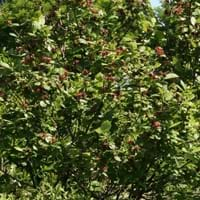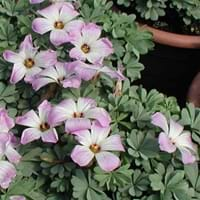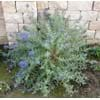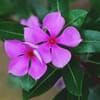Life Span
Perennial
Perennial
Type
Shrub
Bulb or Corm or Tuber
Origin
Hybrid origin
Argentina, Chile
Types
Calycanthus floridus floridus, Calycanthus floridus glaucus
Not available
Number of Varieties
Not Available
Habitat
shaded woods, Woodlands
Shaded sites, Woodlands
USDA Hardiness Zone
5-8
7-9
Sunset Zone
3a, 3b, 4, 5, 6, 7, 8, 9, 14, 15, 16, 17, 18, 20, 21, 22
21,22
Habit
Spreading
Clump-Forming
Flower Color
White, Light Yellow, Violet
White, Fuchsia, Rose, Violet
Flower Color Modifier
Bicolor
Bicolor
Fruit Color
Green
Not Available
Leaf Color in Spring
Green
Light Green, Gray Green
Leaf Color in Summer
Green, Dark Green
Light Green
Leaf Color in Fall
Yellow, Light Yellow, Gold
Several shades of Green
Leaf Color in Winter
Not Available
Light Green
Leaf Shape
Lobed
Heart-shaped
Plant Season
Spring, Summer, Fall
Spring, Summer, Fall
Sunlight
Full Sun, Partial Sun, Partial shade
Full Sun, Partial Sun, Partial shade
Growth Rate
Medium
Medium
Type of Soil
Clay, Loam, Sand
Clay, Loam, Sand
The pH of Soil
Acidic, Neutral
Neutral
Soil Drainage
Well drained
Well drained
Bloom Time
Late Spring, Early Summer
Late Spring, Early Summer, Summer, Late Summer, Early Fall, Fall
Tolerances
Drought, Shade areas
Drought
Where to Plant?
Ground
Ground, Pot
How to Plant?
Cuttings, Divison, Seedlings, Suckers
Divison, Seedlings
Plant Maintenance
Low
Medium
Watering Requirements
Requires regular watering
Water in the early morning hours
In Summer
Lots of watering
Lots of watering
In Spring
Moderate
Moderate
In Winter
Average Water
Average Water
Soil pH
Acidic, Neutral
Neutral
Soil Type
Clay, Loam, Sand
Clay, Loam, Sand
Soil Drainage Capacity
Well drained
Well drained
Sun Exposure
Full Sun, Partial Sun, Partial shade
Full Sun, Partial Sun, Partial shade
Pruning
Remove damaged leaves, Remove dead branches, Remove dead flowers, Remove dead leaves
Remove damaged leaves, Remove dead branches, Remove dead leaves
Fertilizers
All-Purpose Liquid Fertilizer
All-Purpose Liquid Fertilizer
Pests and Diseases
Bacterial Gall, Powdery mildew
Red blotch
Plant Tolerance
Drought, Shade areas
Drought
Flower Petal Number
Semi-Double
Single
Fragrant Bark/Stem
Yes
No
Foliage Texture
Medium
Medium
Foliage Sheen
Glossy
Matte
Attracts
Birds, Insects, Not Available
Insects
Allergy
Toxic if not prepared properly
Asthma, Depression
Aesthetic Uses
Beautification, Cottage Garden
Cottage Garden, Formal Garden, Ground Cover, Showy Purposes
Beauty Benefits
Not Available
Not Available
Environmental Uses
Air purification
Air purification
Medicinal Uses
Antispasmodic, Cardiac, Disinfectant, Diuretic
Not Available
Part of Plant Used
Bark, Root
Flowers
Other Uses
Culinary use, Disinfectant, Repellent
Basketary
Used As Indoor Plant
No
No
Used As Outdoor Plant
Yes
Yes
Garden Design
Feature Plant, Foundation, Mixed Border, Screening, Wind Break
Alpine, Container, Houseplant, Mixed Border, Rock Garden / Wall
Botanical Name
Calycanthus floridus
OXALIS adenophylla
Common Name
Sweetshrub
Chilean Wood Sorrel, Pink Buttercups, Pink Carpet Oxalis, Silver Shamrock
In Hindi
sweetshrub
Chilean Wood Sorrel
In German
sweetshrub
Chilean Wood Sorrel
In French
sweetshrub
Chilean Wood Sorrel
In Spanish
sweetshrub
Chilean Wood Sorrel
In Greek
sweetshrub
Chilean Wood Sorrel
In Portuguese
sweetshrub
Chilean Wood Sorrel
In Polish
sweetshrub
Chilean Wood Sorrel
In Latin
sweetshrub
Chilean Wood Sorrel
Phylum
Magnoliophyta
Magnoliophyta
Class
Magnoliopsida
Magnoliopsida
Order
Laurales
Oxalidales
Family
Calycanthaceae
Oxalidaceae
Genus
Calycanthus
Oxydendrum
Clade
Angiosperms, Magnoliids
Angiosperms, Eudicots, Rosids
Tribe
Not Available
Not Available
Subfamily
Not Available
Not Available
Season and Care of Sweetshrub and Chilean Wood Sorrel
Season and care of Sweetshrub and Chilean Wood Sorrel is important to know. While considering everything about Sweetshrub and Chilean Wood Sorrel Care, growing season is an essential factor. Sweetshrub season is Spring, Summer and Fall and Chilean Wood Sorrel season is Spring, Summer and Fall. The type of soil for Sweetshrub is Clay, Loam, Sand and for Chilean Wood Sorrel is Clay, Loam, Sand while the PH of soil for Sweetshrub is Acidic, Neutral and for Chilean Wood Sorrel is Neutral.
Sweetshrub and Chilean Wood Sorrel Physical Information
Sweetshrub and Chilean Wood Sorrel physical information is very important for comparison. Sweetshrub height is 180.00 cm and width 240.00 cm whereas Chilean Wood Sorrel height is 10.20 cm and width 15.20 cm. The color specification of Sweetshrub and Chilean Wood Sorrel are as follows:
Sweetshrub flower color: White, Light Yellow and Violet
Sweetshrub leaf color: Green
Chilean Wood Sorrel flower color: White, Fuchsia, Rose and Violet
- Chilean Wood Sorrel leaf color: Light Green and Gray Green
Care of Sweetshrub and Chilean Wood Sorrel
Care of Sweetshrub and Chilean Wood Sorrel include pruning, fertilizers, watering etc. Sweetshrub pruning is done Remove damaged leaves, Remove dead branches, Remove dead flowers and Remove dead leaves and Chilean Wood Sorrel pruning is done Remove damaged leaves, Remove dead branches and Remove dead leaves. In summer Sweetshrub needs Lots of watering and in winter, it needs Average Water. Whereas, in summer Chilean Wood Sorrel needs Lots of watering and in winter, it needs Average Water.





